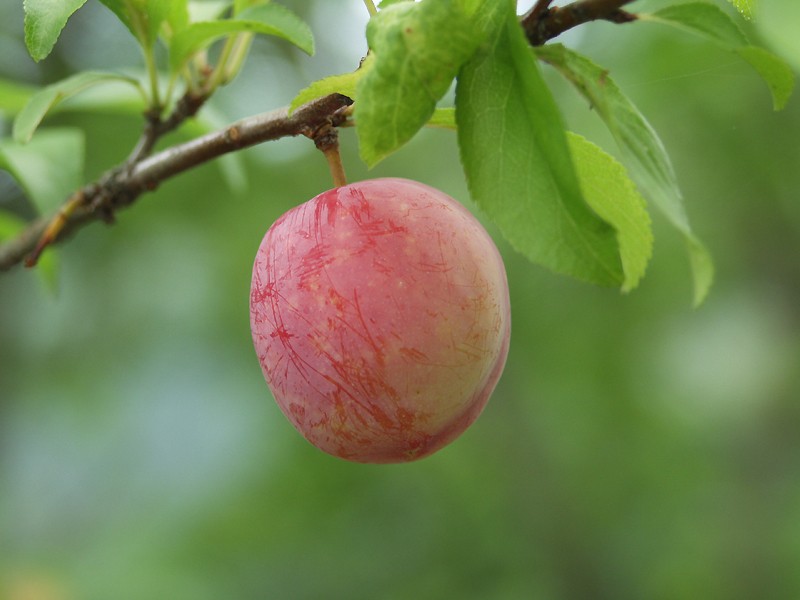- Prunus salicina
Taxobox
name = "Prunus salicina"

image_width = 240px
regnum =Plant ae
divisio = Magnoliophyta
classis =Magnoliopsida
ordo =Rosales
familia =Rosaceae
genus = "Prunus "
subgenus = "Prunus"
sectio = "Prunus"
species = "P. salicina"
binomial = "Prunus salicina"
binomial_authority = Lindl."Prunus salicina" (syn. "Prunus triflora" or "Prunus thibetica"; also called Chinese plum or Japanese plum) is a small
deciduous tree native toChina , and now also grown inKorea ,Japan , theUnited States , andAustralia . It grows up to 10 m tall, and has reddish-brown shoots. The leaves are 6-12 cm long and 2.5-5 cm broad, with a serrated margin. Theflower s are produced in early spring, 2 cm diameter with five white petals. Thefruit is adrupe 4-7 cm in diameter with yellow-pink flesh; it can be harvested in the summer. When fully ripe it can be eaten raw."Prunus salicina" should not be confused with the
Ume , the Japanese name for "Prunus mume", a related species ofplum also grown in Japan, Korea, and China. Another tree, "Prunus japonica" (the Korean cherry), is also a separate species despite having a Latin name similar to "Prunus salicina"'s common name.Uses
Culinary
In China, candied fruits are also sold preserved, flavoured with sugar, salt, and
liquorice . In Japan, it is also used half ripe as a flavouring in aliqueur called "sumomo shu" (すもも酒), [http://www7.airnet.ne.jp/yamadaya/sumomo.gifphoto] and in China a liquor is made from the fruits. [http://www.myttc.cn/viewpro.jsp?id=4867&proid=7033]Medicinal
The fruits are also used in
Traditional Chinese medicine .Etymology
The species name is derived from the Latin word for
willow . [http://www.ibiblio.org/pfaf/cgi-bin/arr_html?Prunus+salicina&CAN=COMIND]"Prunus salicina" is referred to in Chinese as 李 (pinyin: lǐ); it is also commonly called 中国李 (pinyin: Zhōngguó lǐ, lit. "Chinese plum"); and for its fruit, 李子 (pinyin: lǐzi). In Japanese, it is called sumomo (
kanji : 李 or 酸桃,hiragana : すもも,katakana : スモモ; lit. "sour peach" or "sour fruit"). In Korean, it is called jadu (자두), which derives from a corruption of the original Sino-Korean form, "jado" (lit. "purple peach").The surname Li (李; pinyin: Lǐ; also sometimes spelled "Lee", lit. "plum tree") is the most common surname in
China , and also in the world. TheVietnam ese equivalent is Ly. TheKorea n equivalent is Yi (hangul : 이,hanja : 李; also romanized "Lee" or "Rhee", or, less commonly, "Li", "I", or "Yee").Cultivation
Many different varieties of "Prunus salicina", some being hybrid species, are cultivated in
China . "Prunus salicina" is also widely cultivated inJapan andKorea . It has also been introduced to a number of other countries. For example, it is widely grown inAustralia , and dominates the stone fruit industry inWestern Australia . [http://www.agric.wa.gov.au/servlet/page?_pageid=449&_dad=portal30&_schema=PORTAL30&p_start_url=/pls/portal30/docs/FOLDER/IKMP/AAP/HBH/BULLETIN4298_PLUM.HTM] Most of the fresh plums sold in North American supermarkets are "P. salicina" cultivars. The ancestral stocks of these cultivars were greatly improved in Japan and thence introduced into the United States in the latter half of the 19th century, where subsequent breeding produced the cultivars whose fruit is commonly sold in American markets today. Many of these American cultivars have been exported to other countries, including back to Japan, their ancestral place of origin. The traditional East Asian cultivars produced fruit that is quite small, whereas the modern varieties sold in Japan, Australia, and North America are typically larger.External links
* [http://www.ibiblio.org/pfaf/cgi-bin/arr_html?Prunus+salicina&CAN=COMIND Prunus salicina]
* [http://www.plantnames.unimelb.edu.au/Sorting/Prunus_Pt3.html Sorting Prunus names]
Wikimedia Foundation. 2010.
